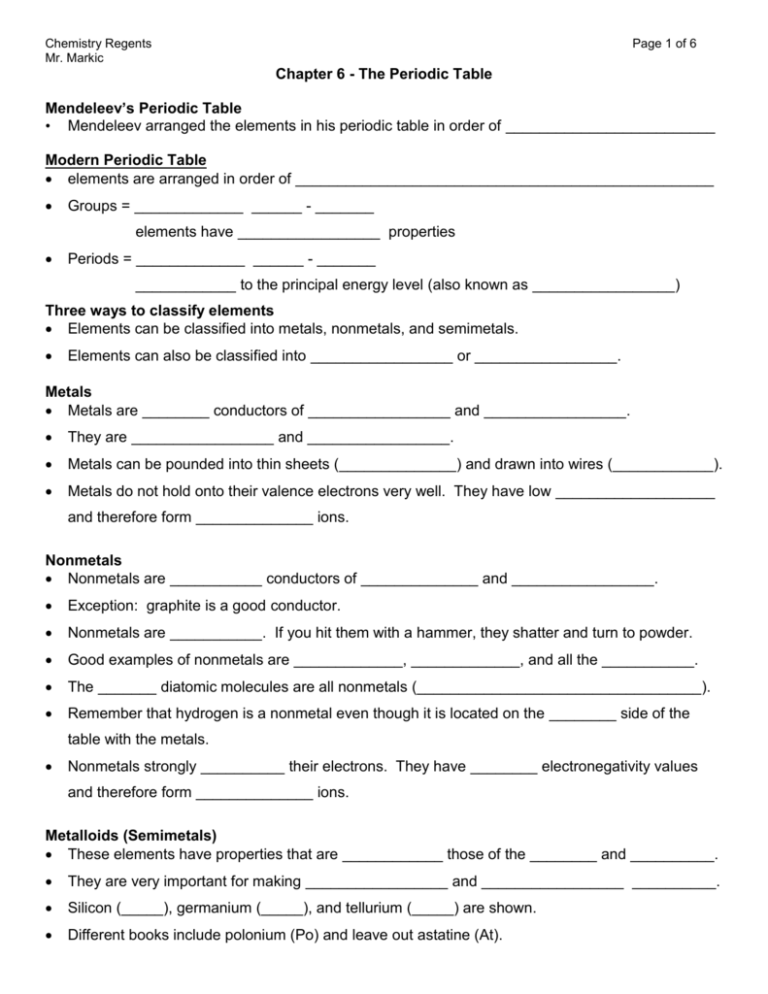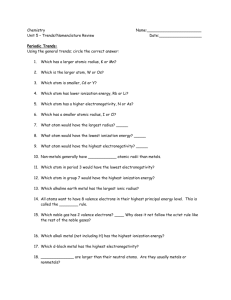File - Mr. Markic`s Chemistry
advertisement

Chemistry Regents Mr. Markic Page 1 of 6 Chapter 6 - The Periodic Table Mendeleev’s Periodic Table • Mendeleev arranged the elements in his periodic table in order of _________________________ Modern Periodic Table elements are arranged in order of __________________________________________________ Groups = _____________ ______ - _______ elements have _________________ properties Periods = _____________ ______ - _______ ____________ to the principal energy level (also known as _________________) Three ways to classify elements Elements can be classified into metals, nonmetals, and semimetals. Elements can also be classified into _________________ or _________________. Metals Metals are ________ conductors of _________________ and _________________. They are _________________ and _________________. Metals can be pounded into thin sheets (______________) and drawn into wires (____________). Metals do not hold onto their valence electrons very well. They have low ___________________ and therefore form ______________ ions. Nonmetals Nonmetals are ___________ conductors of ______________ and _________________. Exception: graphite is a good conductor. Nonmetals are ___________. If you hit them with a hammer, they shatter and turn to powder. Good examples of nonmetals are _____________, _____________, and all the ___________. The _______ diatomic molecules are all nonmetals (__________________________________). Remember that hydrogen is a nonmetal even though it is located on the ________ side of the table with the metals. Nonmetals strongly __________ their electrons. They have ________ electronegativity values and therefore form ______________ ions. Metalloids (Semimetals) These elements have properties that are ____________ those of the ________ and __________. They are very important for making _________________ and _________________ __________. Silicon (_____), germanium (_____), and tellurium (_____) are shown. Different books include polonium (Po) and leave out astatine (At). Chemistry Regents Mr. Markic Page 2 of 6 Reference Table Trends: 1. Across a period, metallic character → Why? 2. Down a group, metallic character → Why? Sample Exercise Which of these sets of elements have similar physical and chemical properties? a) Oxygen, nitrogen, carbon, boron c) Nitrogen, neon, nickel, niobium b) Strontium, magnesium, calcium, beryllium Name two elements that have properties similar to those of the element sodium • Identify each element as a metal, metalloid, or nonmetal • a) Gold c) Sulfur b) Silicon d) Barium Identify each property below as more characteristic of a metal or nonmetal a) Gas at room temperature d) Poor conductor of electric current b) Brittle e) Shiny c) Malleable In which pair of elements are the chemical properties of the elements most similar? a) Sodium and chlorine b) Nitrogen and phosphorus c) Boron and oxygen Chemistry Regents Mr. Markic Page 3 of 6 Classifying the Elements Alkali Metals – Alkaline Earth Metals – Halogens – Noble Gases – Representative Elements – Transition Elements – Classifying Review Which of the following are transition metals? Cu Au Sr Al Cd Ge Co Periodic Trends 1. Trends in Atomic Size 2. Trends in Ionization Energy 3. Trends in Ionic Size 4. Trends in Electronegativity 1. Trends in Atomic Size (Table _____) Atomic Radius – one _______ of the distance between the nuclei of two atoms of the same element Group Trends in Atomic Size From top to bottom the size trends __________________ Why? Period Trends in Atomic Size From left to right the size trends _________________ Why? Chemistry Regents Mr. Markic Page 4 of 6 Sample Exercise • Which element in each pair has atoms with a larger atomic radius? a) Sodium or lithium c) Carbon or germanium b) Strontium or magnesium d) Selenium or oxygen Arrange these elements in order of decreasing atomic size: sulfur, chlorine, aluminum, and sodium. Ions Form when ____________ are __________________ between atoms An ion with a ____________ charge (_______ electrons) is called a ____________ An ion with a ____________ charge (____________ electrons) is called an ____________ Ionization Energy - the energy required to ____________ an electron from an atom (table_____) 2. Trends in Ionization Energy Found on table ______ The ability to become a ____________ charge Group Trends in Ionization Energy • From top to bottom IE __________________ (____________ to take away e-) Why? Period Trends in Ionization Energy From left to right IE increases (difficult to take away e-) Why? Sample Exercise • Which element in each pair has greater first ionization energy? a) Lithium or boron b) Magnesium or strontium c) Cesium or aluminum Chemistry Regents Mr. Markic • Page 5 of 6 Arrange the following groups of elements in order of increasing ionization energy. a) Be, Mg, Sr b) Bi, Cs, Ba c) Na, Al, S 3. Trends in Ionic Size Ion – When an atom __________ or __________ electrons Cation • When an atom ________ an electron (becomes ________) • Radius becomes __________ than the original atom Why? • Anion • When an atom ________ an electron (becomes ________) • Radius becomes __________ than the original atom Why? • Sample Exercise Which particle has the larger radius in each atom/ion pair? a) Na or Na+ c) I or I- b) S or S2- d) Al or Al3+ In each pair, which ion is larger? a) Ca2+ or Mg2+ b) Cl- or P3- 4. Trends in Electronegativity The ability of an atom to __________ an _______________ Found on table ______ Group Trends in Electronegativity From top to bottom; electronegativity values _______________ c) Cu+ or Cu Chemistry Regents Mr. Markic Page 6 of 6 Why? Periodic Trends in Electronegativity From left to right; electronegativity values _______________ Why? Sample Exercise Which element in each pair has a higher electronegativity value? a) Cl or F c) Mg or Ne b) C or N d) As or Ca Which element in each pair has a greater attraction for electrons? a) Ca or O c) H or O b) O or F d) K or S Periodic Property Metallic Character Atomic Radius Ionization Energy Ion Size Electronegativity Across a Period Down a Group










